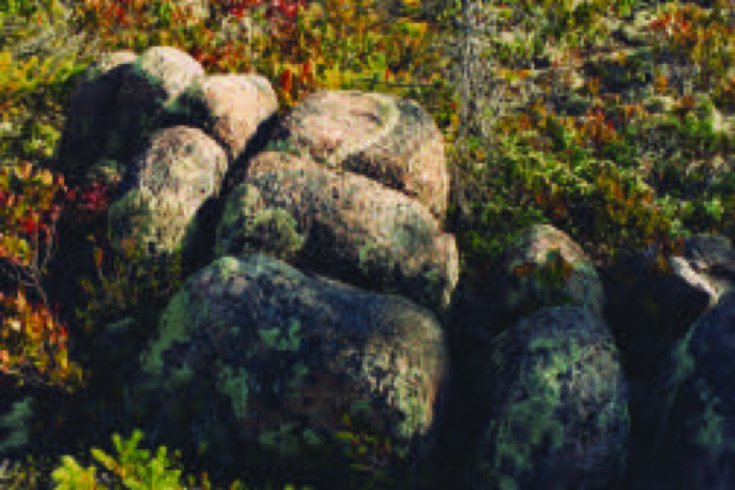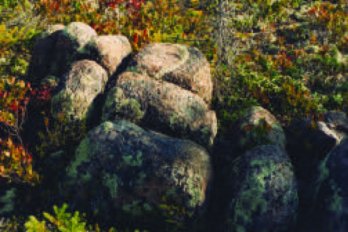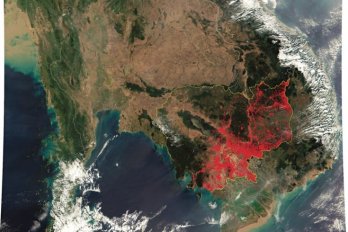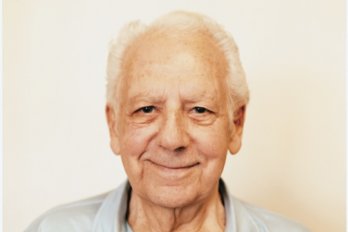
kelly’s mountain — Paul Chiasson surveys our group and asks, “Ready to see some Ming Dynasty graves?” Even in China, the question would be jarring, but on a country road on the northern coast of Cape Breton Island, it is surreal. I don’t have a response except to hoist my backpack and, together with some of Chiasson’s extended family, follow him across the road to an opening in the trees at the base of Kelly’s Mountain.
A Yale-trained architect and an autodidact historian, Chiasson has made Kelly’s Mountain famous in some circles, notorious in others. At the top of the hill, which commands an unsurpassed view of St. Ann’s Bay, he believes he has found not just graves but an entire fifteenth-century Chinese settlement.
As we enter the forest, Chiasson tells me that the road we’re walking on is “an enduring emblem of an advanced civilization,” and that Chinese fleets putting in at St. Ann’s Bay some six hundred years ago built it. The path, which he stumbled across while hiking in 2002, was his first clue that he had found something unique. Since that day, he has been up this hill dozens of times.
Chiasson is a wiry and intense Cape Bretoner who now calls Toronto home. He is living with aids, and his family is worried that he might fatigue. They would rather we not talk during the hike, but to me it looks as though Chiasson could go for hours propelled by nothing but enthusiasm for his discovery and his recently published book on the subject, The Island of Seven Cities: Where the Chinese Settled When They Discovered North America.
I was in the third group to visit the site with Chiasson. The first included Gavin Menzies, a former British submarine commander whose book 1421 garnered attention for its premise that Chinese fleets circumnavigated the globe, exploring not just the New World but Antarctica and Australia during the fifteenth century. The book has drawn criticism for its extravagant, highly specu-lative claims. The Island of Seven Cities is modest in comparison, an exercise in revisionist history on a local scale.
As we get closer to the summit, the road gains definition. “You can see the gravel,” says Chiasson. “This is man-made.” We reach a steep portion of road with boulders and earth mounded up on either side. “We’re passing through the gates now,” he explains. “There are the remains of a wall.” He points to either side of the road; I can make out what seems to be a ridge of earth extending in both directions.
Once at the summit, we find ourselves in the middle of what Chiasson believes was the Chinese citadel. He points out piles of rocks on the hillside — platforms that once supported Ming Dynasty structures, he says. As he speaks, I try to imagine two-storey Chinese buildings, circular stone doorways, and massive junks in the bay below. His brothers chime in occasionally, pointing out other features of the site. If they are skeptical of Chiasson’s theory, they don’t let on.
We take a side trip down the hill to find the burial sites Chiasson promised. “There could be gold or jade in the graves,” he says. The possibility of looting worries him, which is one reason he has tried to keep publicity to a minimum. After some searching, he can’t locate any of the five graves he says he has found. We walk back to the road, where for the next two hours we survey what Chiasson has identified as the remains of walls, farmland, stones with mason marks, man-made ponds, and thin slate slabs that look like tiles. He talks about his theory that the local Mi’kmaq people incorporated some Chinese traditions and about his research into early explorers’ accounts and maps, which he says reveal that a settlement once stood on the site.
Chiasson is aware that an outsider might be dubious, but he remains steadfast. “I’m the Darwin here,” he says, laughing. He’s convinced that while it might take years, others will eventually accept that his beloved mountain will rewrite history. “I love this piece of land,” he says.
Lynn Baechler, a Cape Breton hydrogeologist, is enchanted by Kelly’s Mountain too. She’s been returning regularly to the site ever since working here in 1989. “I drove a Suburban up that mountain every day for three months,” she tells me over the phone. According to Baechler (and a good deal of official documentation), the road that Chiasson contends the Chinese fashioned to get to their hilltop settlement was constructed in the summer of 1989 to facilitate exploration and testing by Kelly Rock Limited, a company based in nearby Sydney.
Baechler has an explanation for every feature on the mountain that Chiasson maintains is Chinese. “The courtyards are actually areas that were cleared off for the test drills,” she says. “The remains of the wall are most likely related to a 1952 fire road.” Pictures she took in 1989 show that the road up the mountain was clearly built that year. A team of archaeologists led by David Christianson of the Nova Scotia Museum has also been to the top of Kelly’s Moun-tain. They confirm that all the man-made features there are of twentieth-century origin.
Chiasson is unwavering in his faith, though. When I asked him via email about the contradictory evidence, his response was, “You have seen the stone features on the site and the mason marks on the stone tiles. When I started this project, I realized that I would have to trust journalists to answer [such] reasoning.”
The more I looked at the photos I had taken of the stone tiles and marked-up rocks, though, the more natural the objects seemed to me. I had come to Kelly’s Mountain expecting to see ruins, but ultimately the hilltop was simply a particularly amazing spot on a beautiful stretch of Cape Breton.
What stood out most from the tour was not the idea of ancient Chinese settlement in Canada. Rather, it was the memory of our descent. As we made our way down the mountain, Chiasson spoke not of the Ming Dynasty, but instead of sites he had seen on a 2000 trip to the Middle East. We talked about the great Crusader castles, especially the massive Krak des Chevaliers in Syria. His description of the castle was vivid and rich, his passion palpable.
But soon his brisk pace left me breathless, and I had to slow down, along with his family. Chiasson continued down Kelly’s Mountain, leaving the rest of us far behind.•





